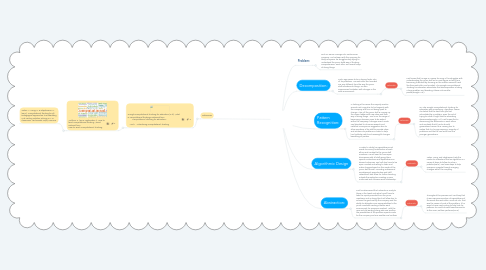
1. References
1.1. Google Computational Thinking for Educators. (n.d,). What is computational thinking? Retrieved from Computational Thinking for Educators - - Unit 1 - Introducing Computational Thinking
1.1.1. Wolfram, S. (2016, September 7). How to teach computational thinking. Wired. Retrived from How to Teach Computational Thinking
1.1.1.1. Yadav, A., Hong, H. & Stephenson, C. (2016). Computational thinking for all: Pedagogical approaches to embedding 21st century problem solving in K-12 classrooms. TechTrends, 60(6), 565-568.
2. Abstraction:
2.1. Paul has discovered that unless he is ready to throw in the towel and retire he will have to take the inputs provided from the junior members, and in doing this it will allow him to achieve the goals set by the company and the ability to delegate more responsibilities to the junior members creating a better work environment for everyone involved. With the new and old working along side one another the possibilities of the positive impacts made for the company and one another are limitless.
2.1.1. Rationale:
2.1.1.1. Throughout this process Paul could say that it was miscommunication of expectations of the words like work ethic, mind set, etc. that was the cause of most of the problem. If he were to have used coding to help look for patterns, he could do word searches similar to the ones Wolfram performs(2016).
3. Algorithmic Design
3.1. In order to clarify his expectations Paul needs to convey his definition of work ethics and mindset to the junior staff members. He will need to have open discussions with all staff giving them specific instructions and explanations on desired outcomes. Paul will also have to be open minded and willing to listen and make changes based on the needs of the junior staff as well. Providing Professional Development opportunities and staff retreats will also allow for further bonding outside the workplace creating a more uniformed and cohesive work relationship.
3.1.1. Rationale:
3.1.1.1. Yadav, Hong, and Stephenson help the reader to understand that an algorithm is a series of steps to follow to solve a problem(2016). Paul uses steps to help everyone navigate through merging changes within the company.
4. Problem:
4.1. Paul is a senior manager at a Fortune 500 company. He has been with the company for thirty-one years, he struggles daily trying to understand the junior staffs way of thinking, comprehension, work ethic, and overall ways of doing things.
5. Decomposition:
5.1. Paul's age seems to be a driving factor into all his problems. His work ethic and mindset are very different from the way the junior staff members do things. He also experiences frustration with changes in the work environment.
5.1.1. Rationale:
5.1.1.1. Paul knows that his age is a cause for many of his struggles with understanding the junior staff so he must figure out why he is becoming frustrated by focusing on the smaller issues at hand like their work ethic and mindset. The Google Computational Thinking for Educators sites states that decomposition is taking a large problem and breaking it down into smaller pieces(Google, n.d.).
6. Pattern Recognition:
6.1. In looking at his issues the majority revolve around Paul's age due to his longevity with the company and him not being open to change. Also, all the junior staff is moving up the career ladder with new ideas and their way of doing things. Paul is on the verge of becoming a dinosaur soon to be extinct within the company if changes aren't made. Paul decided to do some research and installed a anonymous suggestion box to allow members of his staff to provide ideas and solutions to problems in order to help him facilitate useful and meaningful changes benefiting all parties.
6.1.1. Rationale:
6.1.1.1. On The Google Computational Thinking for Educators site in Exploring Algorithms Lesson it's stated that the next time you feel intimidated by a problem; even the act of trying to solve it might lead to interesting discoveries(Google, n.d.). Paul knows that in discovering the differences in work ethics and mindsets that it has to do with generational issues, thus causing him to realize that it is his age causing a majority of problems and that he can learn from the younger generations.

